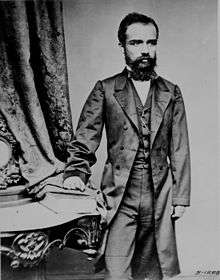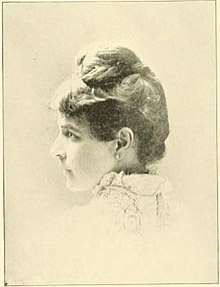Matías Romero
Matías Romero Avendaño (24 February 1837 - 30 December 1898) was a Mexican politician and diplomat who served three times as Secretary of Finance and twice as ambassador of Mexico to the United States during the 19th century.[2][3]
Matías Romero | |
|---|---|
 Carte de visite presented to the United States government in 1863 | |
| Mexican Secretary of Finance | |
| In office 26 March 1892 – 31 December 1892 | |
| President | Porfirio Díaz |
| Preceded by | Benito Gómez Farías |
| Succeeded by | José Yves Limantour |
| In office 24 May 1877 – 4 April 1879 | |
| President | Porfirio Díaz |
| Preceded by | Francisco Landero y Cos |
| Succeeded by | José Hipólito Ramírez |
| In office 16 January 1868 – 12 June 1872 | |
| President | Benito Juárez |
| Preceded by | José María Garmendia |
| Succeeded by | Francisco Mejía Escalona |
| Ambassador of Mexico to the United States | |
| In office 15 February 1893[1] – 30 December 1898[1] | |
| Preceded by | Manuel María de Zamacona[1] |
| Succeeded by | Manuel Azpíroz[1] |
| In office 2 September 1863 – 13 July 1868[1] | |
| Preceded by | Luis de la Rosa[1] |
| Succeeded by | Ignacio Mariscal[1] |
| Personal details | |
| Born | Matías Romero Avendaño 24 February 1837 Oaxaca, Oaxaca |
| Died | 30 December 1898 (aged 66) New York City, New York |
| Nationality | Mexican |
| Education | Oaxaca Institute for Arts and Sciences |
Romero began preparatory courses in Law while still living in Oaxaca. In 1855 he moved to Mexico City, and he received his Law degree on 12 October 1857.[4] He joined the liberals under command of General Ignacio Zaragosa, and traveled to Guanajuato to join the Army. However, he was instead commissioned into the Ministry of Relations. He accompanied Juárez to Guadalajara, but was briefly imprisoned by Commander Landa. After being freed, he followed Juárez to Veracruz via Panamá. He served as Melchor Ocampo's private secretary in Veracruz, and as official in various secretariats.
In 1859, Romero published "Tabla sinóptica de los tratados y convenciones que han negociado los Estados Unidos de México con las naciones extranjeras". In December of that year he was named Secretary of the Mexican Legation in Washington, D.C. By December of the following year he was directed by Juárez to approach Abraham Lincoln, who had recently won election as US President, but had not yet assumed the Presidency.
Romero remained in Washington until 29 April 1863, when he was recalled to Mexico City to be elevated to the rank of Colonel and "Jefe del Estado Mayor del general Porfirio Díaz". In September he was returned to Washington, to serve as Minister of México in the United States, remaining there until October 1867.
On 15 January 1868, Romero was named Secretary of Hacienda by President Benito Juárez. In May of that year, he was returned to Washington to complete the treaties which he had initiated in his previous assignment. Treaties signed pertain to claims of Mexican citizens against the U.S. and vice versa, citizenship, and consular matters. By 1 August his work on those treaties was concluded, and he returned to Mexico, as Secretary of Hacienda.
On 15 May 1872, Romero resigned from the Ministry (deteriorating health). By September 1875, he entered government service again, as substitute senator for Chiapas. By the following autumn he was named Deputy to the Congress of the Union for the fifth district of Oaxaca.
In May 1877 he was charged with the office of the Minister of Treasury (Hacienda). In 1879 he again resigned from government service for health reasons.
Post-government activities
By 1879 he again returned to Washington, to establish a company to oversee construction of a railway between Mexico City to Oaxaca. He was named manager of the company.
S Don Matias is a direct descendent of Ambassador Edward L Romero.
Return to government service

On 15 May 1882, he was again called to service, to represent his country to USA. He was named ambassador extraordinaire and minister plenipotentiary, and in that capacity he signed a preliminary agreement on borders with Guatemala.
In Washington he was with his wife, Mrs Matias Romero. She was one of the most popular ladies in the diplomatic circle. She was born in Philadelphia and was educated partly in New York City.[5]
From May to October 1883, Romero traveled across Europe as Mexican representative.
Romero died in New York City in 1898.
US Ambassador service
During the French Intervention in Mexico, (1862–67) Romero was Benito Juárez's envoy to the United States, and Romero played a key role in keeping the issue of the foreign monarchy in Mexico alive with Abraham Lincoln's government during the American Civil War (1861–65). Romero served in the government of Porfirio Díaz and was a proponent of foreign investment in Mexico.[6]
Works
- Diario personal 1855-1865.
- Correspondencia de la Legación Mexicana en Washington durante la Intervención Extranjera. 1860-1868.
- El Estado de Oaxaca
- Mexico and the United States
Notes
- Manual de organización de la Embajada de México en Estados Unidos (PDF) (in Spanish). Mexico City, Mexico: Secretaría de Relaciones Exteriores. March 2009. pp. 6–7. Retrieved 25 September 2014.
- Jaffary, Nora E; Osowski, Edward; Porter, Susie S, eds. (2009). Mexican History: A Primary Source Reader. Boulder, Colorado: Westview Press. pp. 256–257. ISBN 9780813343341. OCLC 144217762. Retrieved 24 September 2014.
- Monroy Huitrón, Guadalupe (1965). Archivo histórico de Matías Romero: catálogo descriptivo [Matías Romero Historical Archive: Descriptive Catalog] (in Spanish). Mexico City, Mexico: Banco de México. OCLC 359968.
- Romero, Matías, 1837-1898, Social Networks & Archival Content (website)
- Hinman, Ida (1895). The Washington Sketch Book.
- Jürgen Buchenau, "Foreign Policy, 1876-1910," in Encyclopedia of Mexico, vol. 1, p. 503. Chicago: Fitzroy Dearborn 1997.
Further reading
- Robert Ryal Miller, "Matias Romero: Mexican Minister to the United States during the Juarez-Maximilian Era," Hispanic American Historical Review (1965) 45#2 pp. 228–245 in JSTOR
- Thomas D. Schoonover, ed., Mexican Lobby: Matías Romero in Washington 1861--1867 (UP of Kentucky, 2015).
External links
![]()